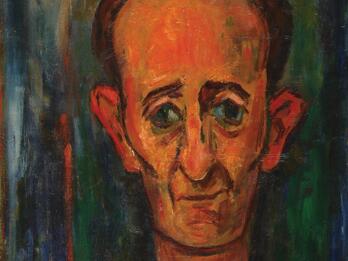Der Nister
Born Pinkhes Kahanovitsh in the storied Jewish city of Berdichev in the Russian Empire (today Berdychiv, Ukraine), Der Nister (“The Hidden One”) is considered one of the most original writers in the Yiddish literary tradition for prose that wove together mystical themes, modernist symbolist technique, and fantastical fairy-tale landscapes. While working as a teacher of Hebrew in 1907 and 1908, he drew attention in the Yiddish literary scene for daring, if still immature, stories that wove together Hasidic, mystical, and erotic themes. But it was over the decade that followed that Der Nister produced his first great work in the ambit of a circle of Yiddish writers and activists in Kiev who, under the guidance of the writer Dovid Bergelson and the critic Nahman Mayzl (1887–1966), helped reorient Yiddish literature toward more unabashed literary experimentation and modernism. After the fall of the tsarist regime in February 1917, Der Nister took part in the ambitious Yiddishist cultural and educational work of the Kiev-centered Kultur-Lige (Culture League), producing a range of original and translated Yiddish prose and poetry for children. His translations of Hans Christian Andersen’s stories were notable for their faithfulness to the original text, including their abstention from any “Judaizing” edits of the originals’ Christian imagery and themes. Much of Der Nister’s writing from 1908 through 1918 can be read as intended for adults and children alike. He returned to the Soviet Union in 1926 (after five years in Berlin) despite knowing that his esoteric stories would be met by extreme displeasure from the communist Yiddish ideological establishment. In the late 1930s, under pressure to produce “proper” socialist-realist prose, Der Nister changed direction stylistically and produced Di mishpokhe Mashber (The Family Mashber), an expansive historical novel reflecting his home city of Berdychiv in the throes of nineteenth-century modernization. A member of the Jewish Anti-Fascist Committee during World War II, Der Nister fell victim to the Soviet regime’s postwar campaign of imprisonment and murder of Jewish intellectuals suspected of “nationalism.” Imprisoned in the Gulag system under inhumane conditions, Der Nister died in a prison hospital in 1950.


